

The following nunneries in Città di Castello have separate pages in this website:
-
✴Santa Cecilia in Paradiso and San Giuseppe (which merged with it in 1815);
-
✴SS Ognisanti; and
Congregation of Blessed Santuccia
The Blessed Santuccia Carabotti established some twenty nunneries in Tuscany, Umbria and the Marches in the late 13th century, which she formed into a Benedictine congregation. The nuns were formally Serve di Maria (servants of Mary), but they were often known as the Santucce. The Templars gave them the church of Santa Maria in Julia (later Sant’Anna dei Funari), Rome, and this became their mother house.
The congregation included three nunneries near Città di Castello that the Blessed Santuccia established in ca. 1271:
-
✴the Monstero delle Santucce, just outside the city walls;
-
✴the Monastero di San Lorenzo, at Sansepolcro; and
-
✴the Monastero di Santa Maria del Ponte, at Pietralunga.
The activities of all of them coalesced within the city walls over the centuries, as described below.
Monstero delle Santucce (1271)
Blessed Santuccia established this nunnery outside Porta Santa Maria with the approval of Bishop Nicolò. (The nunnery was more formally dedicated as SS Filippo e Giacomo). It fell into ruins in the early 15th century, and the nuns moved to what became the Monastero di SS Benedetto e Egidio (below) in 1410. Via delle Santucce (see Walk I) is named for this long-lost nunnery.
Monastero di SS Benedetto ed Egidio (1410)
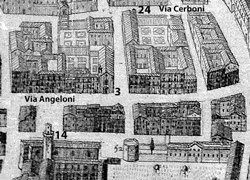
Detail from the plan (ca. 1675) of Città di Castello
by Filippo Titi (Biblioteca Comunale “Giosue Carducci”)
As noted above, the nuns from the Monastero delle Santucce moved here in 1410. It seems that this new complex in what is now Via Cerboni [24], behind the church of Sant’ Egidio [3], included land that had been confiscated from the Giustini family.
In 1477, the abbess of Santa Maria in Giulia ordered that the nunnery should absorb two others of the congregation: the Monastero di San Lorenzo, Sansepolcro and the Monastero di Santa Maria del Ponte, Pietralunga. The nuns of the latter managed to resist closure until 1574, when they were forced to move to Città di Castello. They stayed at SS Benedetto ed Egidio for a short period, before moving to a new nunnery, Santa Margherita (below). They moved back to SS Benedetto ed Egidio in ca. 1790.
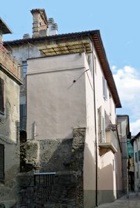
Choir Stalls (early 15th century)
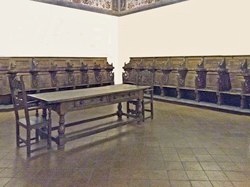

A set of inlaid choir stalls that was in the civic collection by 1897 comprised:
-
✴two groups of nine seats that are now in Room II of the Pinacoteca Comunale; and
-
✴two groups of three seats in Room XVII.
They were documented the Monastero di San Benedetto in 1868, and it is likely that this was the original location of most of them. However, it is possible that the group of three illustrated on the left above, which is stylistically distinct from the others, came originally from another location, possibly San Francesco.
Despite heavy restoration, the stalls can be attributed to the workshop of the Florentine Manno di Benincasa Mannucci (Manno dei Cori) on the basis of his signed work of 1435 in San Domenico.
Monastero di Santa Margherita (1574)
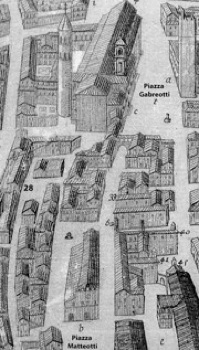
Detail from the plan (ca. 1675) of Città di Castello
by Filippo Titi (Biblioteca Comunale “Giosue Carducci”)
As noted above, the nuns from the Monastero di Santa Maria del Ponte, who belonged to the same Benedictine congregation as those of SS Benedetto ed Egidio (above), established a new nunnery [28] behind the Duomo in 1574. (The nunnery was dedicated to St Margaret of Antioch, not the Blessed Margherita of Città di Castello).
When the Jesuits were forced to leave Sant’ Antonio Abate in 1773, the nuns from Santa Margherita took over their complex. They remained here until ca. 1790, at which point they moved to the Monastero di SS Benedetto ed Egidio (above).
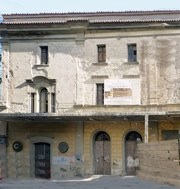
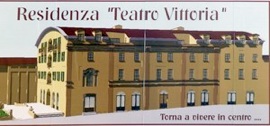
The old complex of Santa Margherita, which subsequently housed the Teatro Vittoria, is now (2013) being converted into apartments.
Monastero delle Giulianelle (13th century)
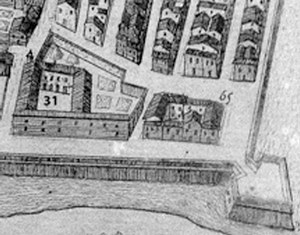
Detail from the plan (ca. 1675) of Città di Castello
by Filippo Titi (Biblioteca Comunale “Giosue Carducci”)
The Monastero delle Giulianelle (more formally known as the Monastero dello Spirito Santo) [31] was first documented in 1268. Its nuns fell foul of Bishop Nicolò in 1270 because they built a church without his consent. The dispute was finally settled and the nuns agreed to adopt the rule of the Franciscan Second Order. However, they subsequently adopted the Benedictine Rule.
An inscription on the high altar of the nuns’ church apparently recorded its consecration by Bishop Ludovico Bentivoglio (1581-1602). Modifications to the nunnery were made in 1690. [The complex was suppressed in ca. 1860 ??]
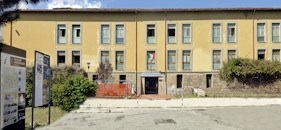
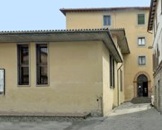
Liceo Ginnasio "Plinio il Giovane" Biblioteca Comunale “Giosue Carducci”
The complex has now been adapted for other uses:
-
✴In 1896, part of the ex-nunnery nearest with city walls was adapted for educational purposes. It now houses the Liceo Ginnasio "Plinio il Giovane" (at 2 Viale Armando Diaz).
-
✴The block behind it, which included the ex-church, now houses the Biblioteca Comunale “Giosue Carducci” (at 16 Via delle Giulianelle ).
Monastero di S Maria Maddalena (14th century)
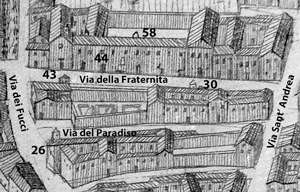
Detail from the plan (ca. 1675) of Città di Castello
by Filippo Titi (Biblioteca Comunale “Giosue Carducci”)
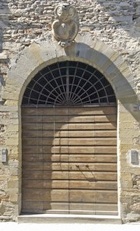
Return to Monuments of Città di Castello.
Return to: Walk I (Monstero delle Santucce; Monastero di Santa Margherita); or
Walk II (Monastero di SS Benedetto ed Egidio; Monastero delle Giulianelle;
Monastero di S Maria Maddalena).

